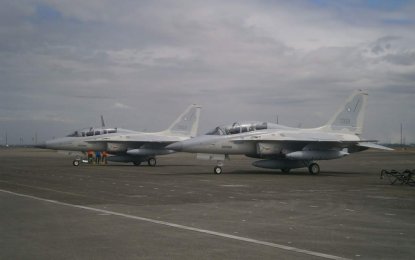Headline
Internal security ops slowing down AFP modernization

Two of the FA-50PH light-interim fighter trainers acquired by the military during Horizon One. (PNA photo by Priam F. Nepomuceno) (PNA Photo)
MANILA — The government’s ongoing campaign against various threat groups are definitely slowing down efforts to modernize the Armed Forces of the Philippines (AFP), Defense Secretary Delfin Lorenzana said Saturday.
“Of course, because money that could have been used for modernizing our troops are used to fight terror. For instance, (in) the five-month Marawi siege, the AFP spent almost PHP4 billion (to fight and defeat the Maute Group terrorists), excluding the amount to care for the IDPs (internally displaced persons) by other agencies that ran into billions as well,” Lorenzana said in response to queries on whether ongoing internal security operations have an effect on the AFP’s modernization.
Fighting in Marawi City began on May 23, 2017 when elements of the Islamic State-inspired Maute Group attacked the city, triggering a battle that ended five months later in October when military units neutralized Abu Sayyaf leader and IS Southeast Asia “emir”, Isnilon Hapilon, along with 1,000 militants.
The same was said by defense department spokesperson Arsenio Andolong during an interview last Wednesday.
“Horizon Three (still) has to be studied and discussed kasi nagbago na ‘yung mix natin (because we have a new mix). May movement na kasi (There has been movement), so that will allow us to now plan for what (equipment and platforms) we need,” Andolong said when asked what the public could expect for Horizon Three of the Revised Armed Forces of the Philippines Modernization Program, which is expected to run from 2023 to 2028.
“(It) pre-supposes that we have already reached the level of credible defense posture, so we will now be concentrating on territorial defense already. But of course, we still have our internal security operations that are ongoing. Isa yan sa mga humahadlang sa ating(That is one of the hindrances to our) modernization because our attention is being divided,” he said.
Horizon Two, which is slated for 2018 to 2022, is the AFP’s transition period from internal security operations to territorial defense.
However, due to the conflicts, the progress of the AFP in this acquisition phase is “somewhere in between” as the defense department is acquiring equipment for internal and external defense usage, Andolong said.
Horizon One lasted from 2013 to 2017 and resulted in the acquisition of the three Del Pilar-class frigates, 12 FA-50PH light-lift interim fighters, and two strategic sealift vessels, to name a few.
The pieces of equipment slated for acquisition during Horizon Two are towed and self-propelled howitzers, multiple launch rocket systems, armored recovery vehicles, five support vehicles, tactical radios, ground mobility equipment (light, medium, heavy), individual weapons, crew-served weapons, and night-fighting equipment for the Army; multi-role fighters, radar systems, light and medium lift aircraft, heavy lift helicopters, unmanned aerial vehicles, attack and combat utilityhelicopters, special mission and long-range patrol aircraft for the Air Force; frigates, corvettes, submarines, amphibious assault vehicles, anti-submarine helicopters, attack craft, medium lift helicopters, and multi-role vessels for the Navy.
Also being eyed are combat engineer, force protection, explosive ordnance disposal, as well as humanitarian assistance, and disaster relief and medical equipment.





















